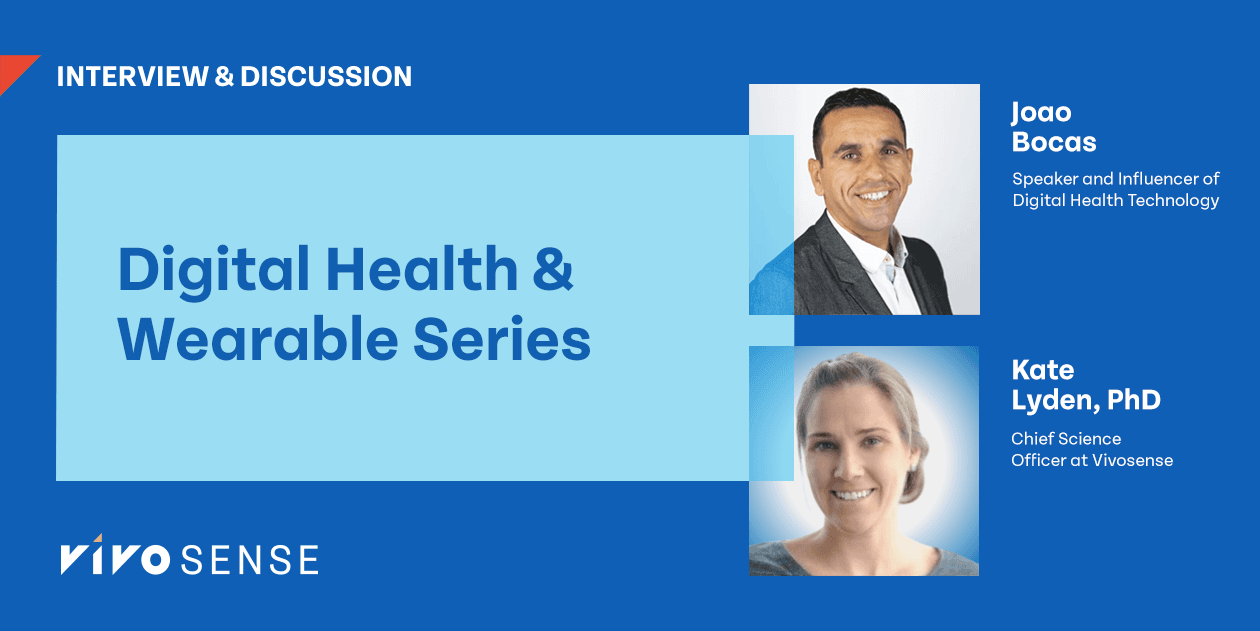Joao Bocas, a keynote speaker and social media influencer for digital health technology, interviewed Kate Lyden, Chief Science Officer at Vivosense, to discuss trending topics surrounding the transformation of moving clinical trials into the real world. They talked about the impact of the pandemic, barriers to adoption, therapeutic areas that can benefit, and some of the hype and hope of novel digital biomarker development.

: The post-pandemic digital transformation seems more pragmatic. So the first question that I have for you, Kate, is how has this effective change impacted your work at VivoSense?

: It’s interesting, Joao. VivoSense has been around since 2010, and the passing of the 21st Century Cures Act in 2016 opened the door for the use of real-world data collected from wearable and connected sensors in regulated trials. So the pandemic’s silver lining has been the catapult of digital health solutions to the forefront of health innovation. We’ve seen this play out with researchers, regulators, and even patients. As a result, they are more open to using digital solutions within drug development. That being said, it’s not all smooth sailing.
Moving Clinical Trials to the Real-World
In 2020, clinical trials started going offline, and sponsors were scrambling to figure out how to continue them. So we had quite a few inquiries from formally disengaged sponsors reaching out to us to learn more about how to move their trials into the real world. The problem was that the structure and the resources weren’t there for them to take on these new solutions overnight. It’s been quite a process for sponsors to incorporate these real-world solutions.
Example of In-Clinic vs. Real-World Clinical Transformation
We specifically had inquiries about moving the 6-Minute Walk Test (6MWT) into a real-world situation, used as an endpoint in many different therapeutic areas. We were able to help them overcome this clinical challenge because we have a measure that parallels the in-clinic 6MWT. We call it the best 6-Minute Effort (B6ME).
B6ME is a real-world measure of a patient’s best natural effort. Unlike the 6MWT, it’s collected passively and derived daily from a wearable actigraphy device. We talked to sponsors about implementing this measure in their trials, but it isn’t an overnight solution.
Rushed Implementation Increases the Potential for Poor Outcomes
As the pandemic basically shut down in-person activity overnight, sponsors had to change gears quickly to keep trials going. Unfortunately, some likely tried to use these solutions without the appropriate, thoughtful study planning and resources. So while yes, we have a momentum boost from the pandemic right now, implementing these tools without strategically thinking through the entire process increases the likelihood of not getting the types of results that sponsors are genuinely looking for.
What Are the Barriers to the Adoption of Digital Biomarkers in Regulated Trials?
Joao Bocus: The second question for you is, what do you see as the most significant barriers to the broad adoption of digital biomarkers in regulated trials? And also, how do we as a community work to overcome these barriers?
Kate Lyden: It’s a loaded question, but I’ll give it my best shot!
Challenge: Lack of Broad Consensus on Data’s True Meaning and Utility
So there are obvious concerns and challenges around data, privacy, data ethics, who owns the data, etc. There are real challenges around operationalizing these tools and implementing them in a meaningful way. There are still questions about what regulators and payers perceive as a benefit; how will they look at the data collected from these tools? I could go on, but right now, at this moment, the biggest challenge is that there’s not a broad consensus on the true meaning and utility of the data that we get from different types of wearable and connected sensors.
Solution: Build Measures Trusted and Valued by All Stakeholders
To push the field forward, what we need to focus on as a community is building measures trusted and valued by all stakeholders; researchers, regulators, providers, and patients. That’s the inflection point that we’re at as a field. Without getting into the nuances of proper measure development, there are a few big-picture mindsets that we can adopt as a community that will help.
- • Build measures from the ground up. Researchers need to invest in the analytical and clinical validation required to bring these measures to scale and systematically invest in the qualitative research required to identify which measures are meaningful for which patient populations. That can’t be overlooked and expressed enough.
- • It’s not a one-size-fits-all approach. While wearable and connected sensors ease the burden of drug trials, we can’t think of this as a one-size-fits-all approach. For every clinical population, the correct development and validation steps need to be taken for every measure. It’s not as simple as throwing an Apple watch on somebody and then stirring the pot to see what we get at the end of the day.
- • Think in the long term. It’s still early days for using wearable and connected sensors and digital biomarkers. If we are going to build these trusted measures, we need to be prepared to change course, address setbacks, and commit to this innovation by investing in multiple efforts and versions.
Joao Bocus: You mentioned the standardization, reliability, and quality of the data. It’s not one-size-fits-all. I’m an advocate and fan of wearables and have done lots of research and work on them. You mentioned that it is a long game, and researchers need to be ready to change course for iterations. Just plugging in wearables is not a solution. Sometimes too much data works against you and from different sources. I like the things you mentioned about building from the ground up and focusing on certain elements, such as the personalization that you mentioned a couple of times.
Which therapeutic areas might see the greatest benefit in developing digital biomarkers?
Joao Bocus: Next question: which therapeutic areas might benefit from developing digital biomarkers the most?
Kate Lyden: There are great use cases across therapeutic areas, and we’re excited at VivoSense for their implementation across many different disease indications. But I’d be lying if I said we didn’t have favorites!
Oncology
Right now, we have a strong focus on the oncology space. One might argue that oncology has been late to the digital game, so there’s great potential to move the needle there. There aren’t very many examples of people successfully using these tools within oncology drug trials. Part of that is because there’s been so much innovation in cancer clinical trials around targeted therapies, platform trials, and, more recently, non-traditional endpoints.
Wearable or digitally-enabled endpoints provide the opportunity to measure cancer patients lived experiences. It’s so important for cancer, in particular, because anti-cancer therapies are often toxic by nature. While we may cure or slow cancer progression, we inadvertently create debilitating side effects that can be short-term or can last many years after treatment has stopped.
Real-World Components of Health Improve Patient-Focused Drug Development
Implementing wearable technology in real-world settings to capture other components of health that are extremely important to cancer patients is essential for patient-focused drug development. In conjunction with more traditional endpoints of survival and tumor size, things like physical function, fatigue, quality of life, etc., can be used and considered by regulators in the risk profile assessment.
Rare Disease
We also have a strong focus on rare disease, which spans thousands of different disease states. One of the overarching themes of studying rare diseases and developing patient treatments is the burden of getting a large enough sample size.
Real-World Settings Can Expand Data Sets and Improve Clinical Trials
Reaching enough patients to enroll in a clinical trial has always been a challenge for the rare disease community. We can expand our recruitment reach by moving these measurements into the real world via wearable or connected technologies. Patients don’t have to travel to the clinic as frequently, and we can collect much larger amounts of data over longer periods. Larger data sets minimize the variability within a patient and even between patients, improving our clinical trial and moving the needle for drug development and rare disease.
Joao Bocus: Thank you, Kate! Your work in rare disease and cancer truly impacts patients’ lives. And with wearables, you can not just gather the data but facilitate the interaction. You mentioned many critical points about knowing more about the patient because it’s not just about the data but also about their behavior, what they are experiencing, and what is important to them.
What is the one overhyped aspect of digital health, and conversely, what gives you hope as the field matures?
Joao Bocus: Moving on to the fourth and last question is around digital health, hype, and hope. What is the one overhyped aspect of digital health, and conversely, what gives you hope as the field matures?
Kate Lyden: You saved the best question for last, Joao. I’m extremely hopeful for the future of digital health and drug development. But like any emerging field, some areas tend to get overhyped.
The Hype: The Oversimplification of AI in Clinical Trials
Right now, digital health is using AI and big data to develop digital biomarkers, and there certainly is great potential to uncover meaningful components of health when used in the proper context. But within the context of patient-focused drug development and developing and validating these real-world digital biomarkers, AI is not the panacea for all drug development and healthcare woes.
A tangible example of this is AI being used within a trial to learn what outcome measures are worth measuring and detect very small changes meant to indicate a treatment benefit. The problem with this approach is that it removes some of the essential underpinnings of clinical trials and patient-focused drug development.
The oversimplification of using AI in clinical trials to move from raw data to important health insights often happens. In particular, it de-emphasizes the need for a clearly formulated and stated research question and a well [a priori 17:32] defined statistical analysis plan, including what constitutes a clinically meaningful difference for the target patient population.
Appropriately using AI and big data within drug development requires we continue to follow the scientific methodology. We need to have clearly stated research questions and can’t use AI to substitute well-curated data sets or clear analytics in an interpretation plan. Tech and analytic companies like VivoSense have a particular responsibility to be really clear on what they mean when using the term AI and address the potential limitations of AI within drug development. Once we do that, we will see AI and big data start to realize their potential.
The Hope: Decentralized Trial Platforms Alignment with Wearables
I’m hopeful for many things within the field right now. Still, one thing that I’m looking forward to seeing progress in the near future is the combination of decentralized trial platforms with wearable and connected devices to collect outcome measures in patients’ real-world environments.
We’ve seen exceptional growth from the DCT trial companies since the pandemic. But until recently, we haven’t seen a meaningful combination of DCT platforms with wearable and connected devices. As we combine these two pieces of technology, we’ll start to move the needle on patient-focused drug development.
Joao Bocus: Brilliant, Kate. There is hype around artificial intelligence, which has become an overused term. We are at the beginning stages, and researchers are trying to figure it out and, in the process, not leveraging the true potential of technology and the wearables. As the industry matures, wearables and artificial intelligence will be the game-changer in healthcare.
